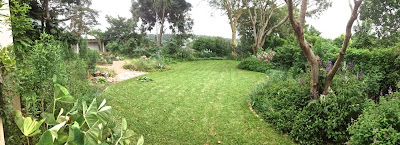 |
| Arum lilies make great plants for rainwater gardens |
Our soils were created to be natural water tanks. Depending on their composition, they (like sponges) have the ability to catch and hold water. They catch hundreds of thousands of litres of water, releasing it slowly over a period of time, either upward to the roots of plants, sideways into rivers, or downward into the groundwater below. Good soil is essentially a reservoir for plants to survive through periods of dryness. So why do we funnel it off into tanks, or even worse let it drain away into the stormwater system?
 | |
| Normal rainwater could be funnelled into the soil where it belongs, and excess water overflows into the stormwater system. |
Instead of using the downpipes to carry water straight into our stormwater system or at least into tanks, the water would flow from the roof down the drainpipes and into a catchment area with plants that would naturally be found in wetlands. These plants can tolerate both waterlogged and dry conditions depending on the season. The water can then drain away naturally into the soil.
 |
| Vancouver's innovative stormwater solution |
This can be a beautiful way of bordering or softening hard areas like parking lots and roads, and in a water thirsty country like ours is an ideal way of conserving water in the place where it should be conserved.





















